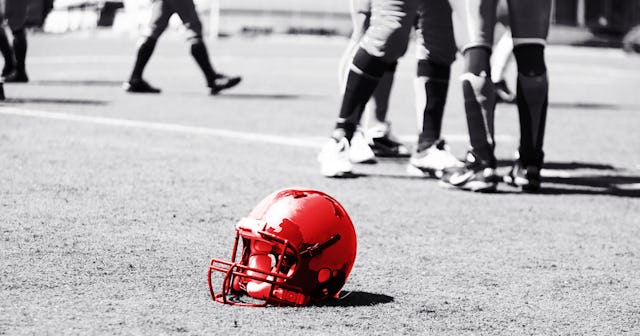How Tackle Football Harms Our Kids More Than We May Know

American football has long been a sport riddled with debate and criticism. Surely we’ve all heard of Colin Kaepernick, who protested police brutality by kneeling during the national anthem in 2020? Have you heard the names Aaron Hernandez or Bubba Smith? These men were NFL players at one point in their lives, diagnosed posthumously with chronic traumatic encephalopathy, or C.T.E, a neurological condition related to brain trauma, along with a sizable and growing list of other NFL and contact sports players.
Among the athletes speaking out about this is former quarterback Brett Favre, who played in the NFL for 20 years. Earlier this week in a PSA, Favre shared, “Having kids play before high school is just not worth the risk.”
Since football season is upon us, here is what you should know about C.T.E — and how it could affect your child.
Most are not officially diagnosed with C.T.E until after death when their brains are studied. C.T.E occurs when brain tissue deteriorates over time due to an abnormal buildup of protein, which happens when there is a continued shaking of the brain within the skull — like whenever the head gets hit, which happens regularly when a person is tackled on the field during a football game.
Favre states in his PSA that tackle football should not be played by a youth younger than 14 years old. Why? There is an increased risk of kids developing C.T.E if their skulls are repeatedly hit. In his touching one-minute PSA, Favre advocates for the mental health of young football players by urging parents to wait to start their kids in tackle football.
C.T.E is a preventable disease. Some of the symptoms which Favre outlines in this video — and science confirms — are that those who suffer from C.T.E can have chronic depression, become violent, have erratic behavior, memory loss, mood swings, and a host of other issues.
Parents can sign kids up for tackle football as young as five years old in some places. If the child continues on through high school, their brains could already be impaired from the trauma of being tackled before they even start first grade. And no one would even know it. There is currently no test to diagnose C.T.E; it can only be diagnosed after death. Contact sports, like boxing and football, open players up to continued hits to the skull. The symptoms I mention here can easily present as a mood disorder or simply teenage growing pains as the once-five-year-old grows into a young person, with symptoms of C.T.E intensifying over time.
RichLegg/Getty
The brain is a fragile organ that controls everything we do. At five, children are very much still developing, especially their brains. From birth to five years old, the brain develops at a rate unlike any other time in one’s lifespan. By the time they enter kindergarten (or make an appearance on the football field), their brains are only 90% formed. Gross motor skills continue to develop right on through to age 12. This is why putting those developing brains at risk is a bad idea, and tackle football might not be the right choice for our kids, at least not until high school, Favre says.
In an interview with USA Today Sports in 2017, former NFL player Bo Jackson stated, “If I knew back then what I know now, I would have never played football. Never. I wish I had known about all of those head injuries, but no one knew that. And the people that did know that, they wouldn’t tell anybody. … The game has gotten so violent, so rough. We’re so much more educated on this C.T.E stuff (chronic traumatic encephalopathy), there’s no way I would ever allow my kids to play football today.”
Hindsight is 20/20.
Thanks to science, we know more about the effects of continued hits to the head — and we can’t un-know it. Which means we now have a choice to make for our kids and their future. We now know that some of the most famous football players are famous for the wrong reasons, like Aaron Hernandez, who was convicted of murder and later died by suicide in prison. After his death, Hernandez’s brain was found to have C.T.E.
Just this year, former NFL player Phillip Adams murdered a family of six in South Carolina and then also died by suicide. He is presumed to have suffered from C.T.E at the time of the murders; a final determination has yet to be made about whether Adams suffered from this disease, but it is suspected.
What we do know for sure is that C.T.E harms players, their families, and communities at large, like the victims of Hernandez’s and Adams’ crimes. As parents, we can only do so much for our kids — but between the ages of 5 and 14, we know what trauma does to the brain. We know that we can refrain from signing our kids up for a game that can all but guarantee harm to them, either during the game or many years after they’ve stopped playing.
Assistant professor of neurology at Boston University’s C.T.E Center, Jesse Mez, shares in an article on WebMD that, “In two people who had the same amount of exposure to football, one may develop the disease and another may not, or one may have severe disease and one may have mild disease.” This leads to the suggestion, he adds, that other risk factors such as genetics are involved. There’s just no way to know at this point; we have a lot to learn about C.T.E.
But we know enough to keep our kids off of the football field for a while.
This article was originally published on